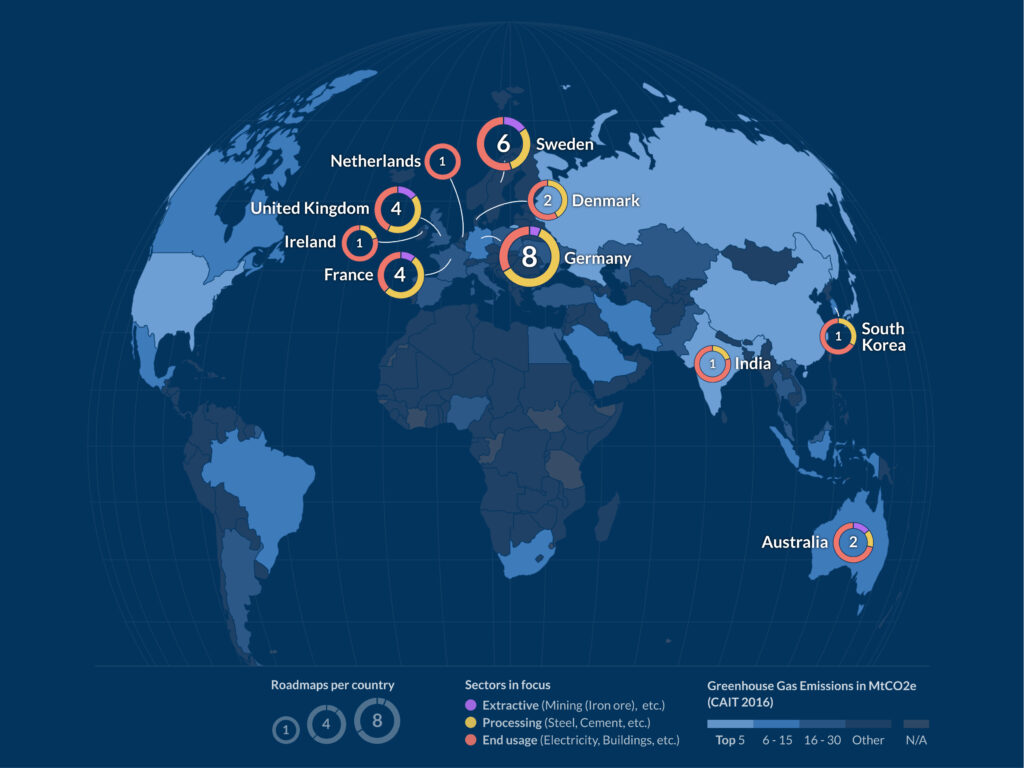SEI’s Zoha Shawoo discusses the Industry Transition Tracker, a database of industry transition roadmaps developed by the Leadership Group for Industry Transition, which allows users to compare, contrast and identify trends in the decarbonization plans of different countries and sectors.

Graphic: Leadership Group for Industry Transition
What is the Industry Transition Tracker?
The Transition Tracker is an online, interactive database of 30 industry transition roadmaps developed by the thirteen countries that are members of the Leadership Group for Industry Transition. We define roadmaps broadly as long-term decarbonization pathways, visions or strategic plans that include decarbonization targets.
The Transition Tracker allows users to explore these roadmaps in an engaging and interactive manner, and to analyse their content across different sectors and different countries. It enables users to pull out key trends, as well as similarities and differences across countries or sectors.
What our Tracker really tracks is the extent to which different countries have different industry transition roadmaps in place, along with what sectors they fall under, what industries they are targeting, and what decarbonization targets they have. In just a few clicks, the Tracker helps users find answers to questions such as “what are the mitigation measures that the roadmaps specifies”, “what actors are leading the development or implementation of the roadmap” and “what are the different kinds of levers available to implement the targets”. It also gives quick insights into what policy levers, financing needs and technology demands are seen as necessary to implement the roadmaps and achieve the decarbonization targets.
Moreover, we have included information on whether it was a government, company or civil society actor that commissioned any given roadmaps. This allows users to understand the extent to which ambition on industry transition is industry- or government-driven.
Who is the Transition Tracker for?
We see it as a very useful tool for government officials and company representatives, as well as civil society and other stakeholders.
The idea is for government officials to go in and find out what is happening in other countries. For instance, a ministry in one country may want to develop their own industry transition roadmaps and can then use the Tracker to find out what is happening in other countries and what best practices are out there that they could learn from. For example, a government ministry in Australia looking to develop a cement roadmap could use the Tracker to filter by sector and find that India has already developed a cement roadmap. They would then be able to see not only the components of this roadmap, but also who commissioned it, so that they’d know who they could contact in order to find out more.
Companies will be able to see what other industry sectors are doing in terms of transition, and what similarities there are in terms of the technologies and mitigation measures that are being asked for. A cement company in Germany might find that Sweden’s cement roadmap identifies certain policy, financing and technology levers that they think their cement roadmap would also require. In that way, the Tracker creates opportunities for cross-learning.
A user might also go into the Transition Tracker and find out that all the cement roadmaps from different countries specify carbon capture and storage, or CCS, as a technology demand. At the same time, all these roadmaps might name financing for research on CCS as a financing need, and pinpoint, as policy needs, particular policies that incentivize CCS.
This kind of sector-wide trend would reveal the different combinations of levers necessary to implement this specific mitigation measure. One could expect a sense of collaboration to emerge from users becoming aware of such similar results across sectors and countries, and the different actors could therefore find a way to deal with these asks from the roadmaps, which would then enable implementation.
For civil society organizations, we see a significant benefit in having all this data in one place that is accessible and easy to engage with. Instead of going to different government or industry websites, users have a one-stop shop for information about industry transition roadmaps.
This would also enable stakeholders to use the Tracker for more research or analytical purposes. For example, users could utilise the Tracker to show hotspots for steel production and simultaneously filter by sector to view all steel roadmaps. By identifying top steel producers that don’t have steel roadmaps in place, users would be able to point out critical gaps.
Graphic: Leadership Group for Industry Transition
How will the Transition Tracker expand in the coming weeks?
The updated version of the Tracker will feature country-specific profiles which give more detailed information on industry transition progress in that country. For instance, it will have information on how many roadmaps there are in one country, what the targets and baselines are, as well as information about that country’s nationally-determined contribution or NDC, and the industry transition measures that are included in the NDC.
The updated Tracker will also have an analytical tool to look at multiple facets of different roadmaps simultaneously, so that users can pull out even more key trends.
Finally, we are also working to expand the Tracker to cover more countries. By early 2021, we expect it to cover industry transition roadmaps in all G20 countries.
Design and development by Soapbox.

